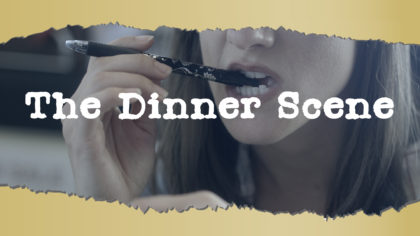Leading up to the release of “The Dinner Scene” on Seed & Spark, I put a series of posts up on Instagram and my public Facebook page (both @NThurkettle), telling behind-the-scenes stories of the inspiration and execution of the short film. Collecting them now here.
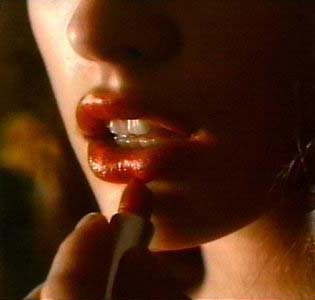
This is where “The Dinner Scene” began – with this close-up of actress Milla Jovovich’s lips in the 1992 film Chaplin, directed by Richard Attenborough with cinematographer Sven Nyquist. I was fascinated by how the choice to isolate on a body part, rather than de-humanizing her, actually focused us on where all the emotion and intention of the moment lived. Not every filmmaker can pull that off, and I started to wonder whether you could actually construct a narrative out of such extreme close-ups, thus creating a protagonist that the audience could invest in, and empathize with, without ever actually seeing them in full. I believe strongly that a movie can’t do all of the “feeling” on behalf of an audience, sometimes your job is to create a vacuum into which the audience pours their own feelings; and I thought, if we could pull off this trick, denying them a full look at the protagonist might trick them into emotionally “leaning forward” a bit. This seemed like an ideal challenge for a short film, where the running time gives you the liberty, if not the obligation, to try something which is possibly crazy. But what story would I tell?
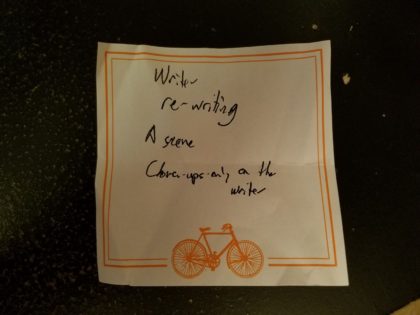
I was out at a bar with a friend when the idea for “The Dinner Scene” leapt to mind; using that scheme of stitching together closeups to plot out an emotional journey to tell the story of a writer at work. I have seen many very good films about writers, but very few which I think capture the process of writing, itself; and the emotional rollercoaster it sends so many sensitive souls on. Given how internal that journey is, it inspired me to consider where we would be able to catch glimpses of it – in the sip of a cup of coffee, a hand hesitating over a pad of paper. This is one case where I was not about to resist the old cliche – “write what you know”.
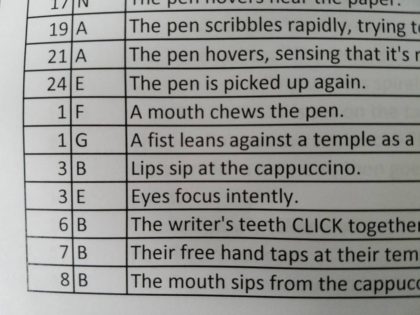
This is what results when you’re trying to tell a story in a progression of extreme close-ups; you essentially have to edit the movie together in your head before you even shoot it. This spreadsheet described every set-up I thought we needed to tell the story visually, and then organized them by which side of the table the shot would originate from, in order to minimize the time spent moving and re-lighting. We would be shooting, for free, in a coffeeshop that was going to stay open to the public, and had pledged to be out by lunchtime, so for many of these brief shots, we would only get one take. To my astonishment, not only did we make it through the list, some 90% of the shots described in this spreadsheet made it all the way to the final cut of the film!

For the half of “The Dinner Scene” set in the coffeeshop, there were only five of us to execute the shoot – myself, cinematographer J. Van Auken, sound recordist Darren Lodwick, makeup artist Nikki Nina Nguyen, and actress Jenaha McLearn. Due to a miscommunication, we didn’t get access to the cafe until an hour after we had planned, which meant we had to double our hustle to have any hope of making the day. And yet we managed to wrap one whole minute early! Our everlasting gratitude goes to the 102 Cafe in Garden Grove for hosting our production – to this day they are supporting the arts with live music and cool, caffeinated drinks all artists need to survive the California heat!
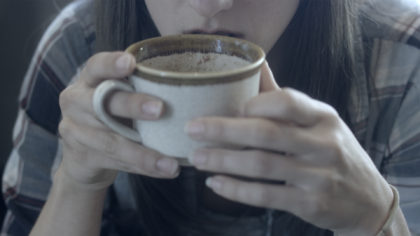
I usually refer to actress Jenaha McLearn as the unsung hero of “The Dinner Scene”. When I approached her about the role, I talked about how difficult the technical element of it was going to be, how little room for error there would be on the shoot, and that we would never see her full face in the movie. Actors like having their full face visible – it’s good for their careers! Despite that, Jenaha was gung ho about the idea and the challenge and threw herself into it.
She has a lifetime of training in dance, and that turned out to be the perfect asset for what we were doing. Shooting super-tight in shallow focus meant that she had to hit an extremely precise spot in 3-dimensional space, while landing the intention and emotion of the moment. And, given that we were shooting out of order, she had to remember the arc of her character and vary the intensity of each moment accordingly.
Time after time, she nailed gestures on the first take, and when I saw it all assembled, I marveled at the number of little vulnerable, neurotic behavioral touches she was able to slip in. You really get a picture of this writer and her emotional rollercoaster, and as close as we were pushed in on her, we never caught any dishonesty. It’s an outstanding performance, and the short would never have succeeded without it. See more of the full spectrum of her talents and her professional achievements on her website.
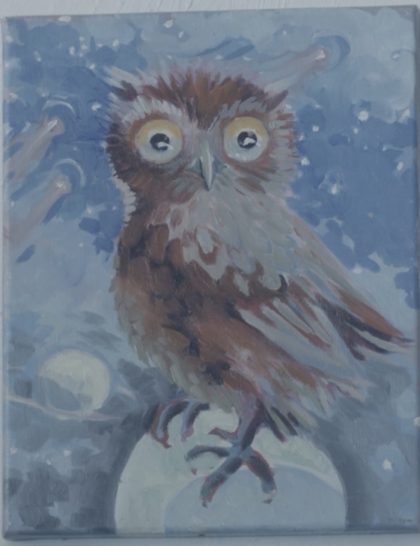
The “Cosmic Owl” is an important figure in “The Dinner Scene”, providing unexpected inspiration to our Writer to get over her creative block. It was a multi-dimensional instance of art imitating life, because I myself was in a coffeeshop, stuck trying to figure out how to finish the script, knowing that the couple in the film-within-a-film needed a subject to argue about that would be dramatically juicy, but not knowing what that might be. Frustrated, I leaned back in my chair, bumped my head against a painting hanging on the wall, and, ta-da!, the script seemingly finished itself.
To pay homage to that moment by using a painting in the film, I knew the painting would need to be a mix of beguiling and whimsical, and yet somehow direct in the way it connected with and challenged the writer. “Cosmic Owl” fulfilled these needs splendidly, and was leant to the production by the terrific Southern California artist Heather McMillen. It has been displayed in cafes and galleries around Long Beach and Orange County and is available for purchase!
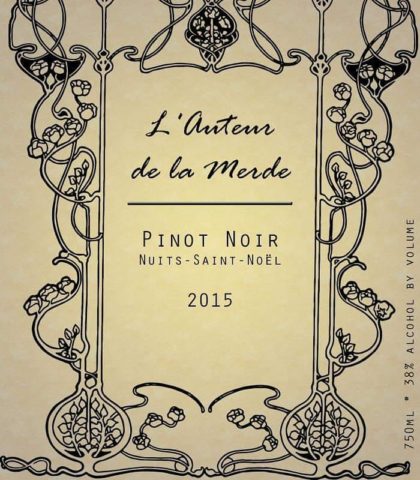
Due to the availability of actors, we didn’t shoot the “dinner” half of “The Dinner Scene” until two weeks after the filming of the “cafe” half. In the interim, I completed a rough cut of the Writer’s half of the story. Timing being so important in comedy, though, I would have to wait until the other footage was in before I could fine-tune.
In addition to producing/writing/directing/editing, I was also the de facto Art Director on the project, which mostly involved mixing up a fake cappuccino that we could top up whenever needed (cold brew with flat whipped cream and cinammon), as well as fake red wine (mostly cranberry juice and flat cola with a bit of cherry syrup for texture).
You are supposed to avoid having real-world brands appear in your film unless you have obtained permission, but I didn’t want my actors having to worry about keeping the wine bottle facing away from camera, so I Photoshopped a fake label. In an in-joke relating to the Writer’s ongoing self-doubt as she imagines this scene, the pinot noir label translates as “The Sh*tty Writer”.
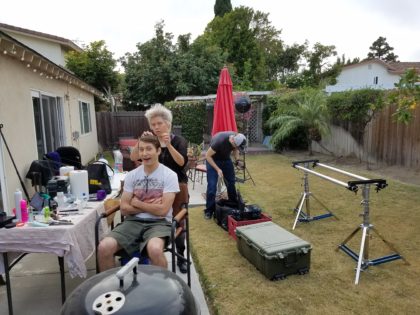
For the second half of production, we convened at the home of my very good friends, John and Amanda Byrd, in the city of Costa Mesa. Their beautiful backyard covered dining patio already had festive lights strung around it, and I thought it would look great on camera, while the gazebo walls would present some fun framing options.
The challenge, though, was that age and dampness had made the structure fragile, and so we had to ensure that at no time during lighting, blocking, or camera movement, would we actually come into direct contact with it. Thankfully, with such a small crew, everyone was able to stay out of one another’s way and avoid thoughtless bumping.
As the sun went down and we started working through the shot list, a layer of damp air came in off the ocean, threatening to turn into a light drizzle, which would not have been at all healthy for the gear we had lying around. Thankfully, we nailed our last shot and got clear just before the moisture got too heavy. While our cafe shoot wrapped a minute early, our challenging evening in the backyard ran over…by four minutes. With a good plan and a team you trust, crazy things are possible!

MacLeod Andrews is one of the country’s leading audiobook narrators, as well as an outstanding stage and film performer who starred in the cult horror film They Look Like People. He also produced and starred in an upcoming feature-length genre hybrid called A Ghost Waits that I co-produced and have a voice cameo in. I’m lucky I can call him a friend as well as a colleague. He’s got extraordinary range as an actor, but what I think he doesn’t get to show off nearly enough is what a wicked and imaginative sense of humor he has.
To play the role of David in “The Dinner Scene”, MacLeod was constantly riding a line of straight-faced and strange, portraying both the heightened romantic melodrama of their film-within-a-film, but also the weird convulsions of a character whose every word and action is under constant review and revision by its creator. There’s a type of comedy I like to describe as “bluff comedy”, where you’re inexorably ratcheting up the absurdity without ever openly acknowledging it, trying to get the audience to break first. Sculpting MacLeod’s performance in the face of his constant inspiration and invention was one of the greatest pleasures of the whole experience – in one moment that flies by in the finished cut, his ex-girlfriend Pamela throws a handful of salad in his face, and he subtly catches a leaf of spinach and starts gesturing with it. I almost blew the take with laughter when he did that.
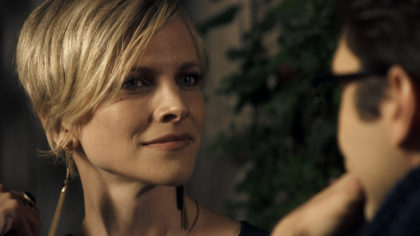
I met Holly Bittinger when she auditioned for a Shakespeare company where I served as casting director. The directors there didn’t opt to use her but I thought she had a rare appetite for acting challenges and a great spirit of fun, so I asked her to keep me in the loop on what she was doing. A different Shakespeare company snapped her up almost immediately.
As “Pamela”, Holly matched MacLeod in energy and comic commitment, which I had guessed could happen and hoped for even though the two never met before showing up on set. Making the “get to know you” part of things even loopier was the fact that, schedule-wise, we needed to shoot the bedroom scene first!
I love watching their battle of wills and the way they navigate into the explosion of pent-up passion. And Holly delivers the most unexpected performance curveball in the piece, suddenly giving voice to the Writer’s real despair and self-doubt in a breathless, downward-spiraling rant which Holly navigated in an unbroken take. I love actors with stage experience in their portfolio, because I know that if I set up a shot where we are going to slowly push in on them for over a minute and they have to hit seven different emotional checkpoints and can’t break connection to the moment; they’ll deliver.
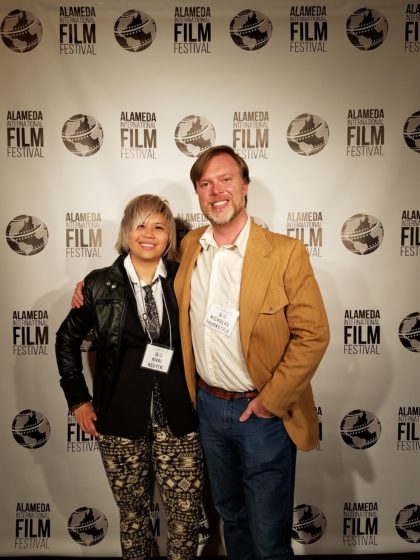
“The Dinner Scene” made its festival premiere almost exactly one year ago at the Alameda International Film Festival up in the San Francisco Bay Area. Alameda began as the Long Day Short Film Festival, and while their programming has expanded to features, they still have a strong love for shorts – daring shorts, local shorts, international shorts.
Road tripping up from Orange County with me was the film’s makeup artist and one of my dearest friends, Nikki Nina Nguyen. We both absolutely love the travel aspect of film festivals – getting to know and explore a new place, as well as meet the area’s most passionate film lovers. On this trip we got to see our film screened twice, and enjoyed many other fantastic films as well as live music, a memorabilia auction, and a spontaneous evening’s train ride into San Francisco (where we split a plate of gnocchi at Francis Ford Coppola’s restaurant).
In the months after, the film racked up a truly astonishing number of festival plays. I’ve put many, many hours over the last couple of years into studying the festival world in order to develop my submission strategy. When you’re sweating every dollar, you need a clear idea of your goals and your reasoning for each spend; because I was going to be spending more on submission fees than I spent making the movie. I thought that we had a chance of traveling well, given that we were a broadly-appealing comedy that ran under ten minutes (9’57”, to be exact!) That’s very programmable, assuming the movie works. But as the acceptances rolled in – and even a couple of awards(!!!) – it overshot even my most ambitious definition of success. The best moments were when I was able to travel to the festivals, and be there in the crowd when a big joke landed and blew up the room. That’s what every bit of this work was for.
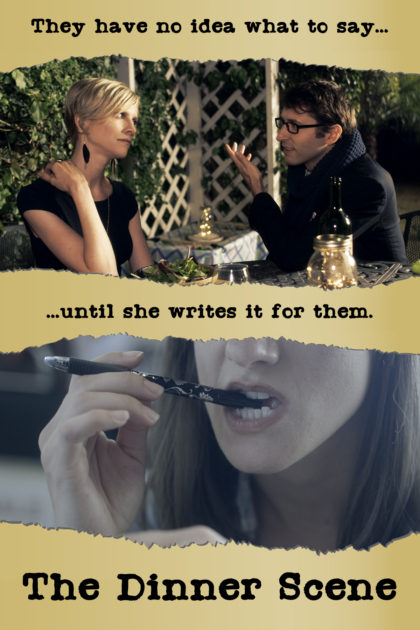
When you watch “The Dinner Scene”, it never flat-out explains its gimmick to you. It’s only by watching the Writer’s scribbling and the cross-cutting between the cafe and the dining porch that you understand the relationship between the two places. Our exceptional cinematographer/colorist, J. Van Auken, underlined the difference by shooting the Writer in natural light with muted colors, while putting Pamela and David in more vivid, saturated colors with intense, “Hollywood” lighting, placing them in a more fantastical world.
Which gave us a very clearly-defined bar to clear. There are jokes throughout the short, especially in the second half, that specifically pay off the audience’s understanding of the “rules” of what they’re watching. If they haven’t been paying attention, and the movie didn’t successfully establish what was happening, there would be no laughter. Thankfully, there was; and as multiple screenings passed I could see the normal trajectory of laughter like a curved line running through the movie. It was a total affirmation that you don’t have to talk down to an audience; that if they’re watching with engaged curiosity, you can take them somewhere they didn’t expect and they’ll be delighted. Making short films has effectively been the film school I never went to, and the opportunity to experiment with storytelling approaches like this was worth every penny.
